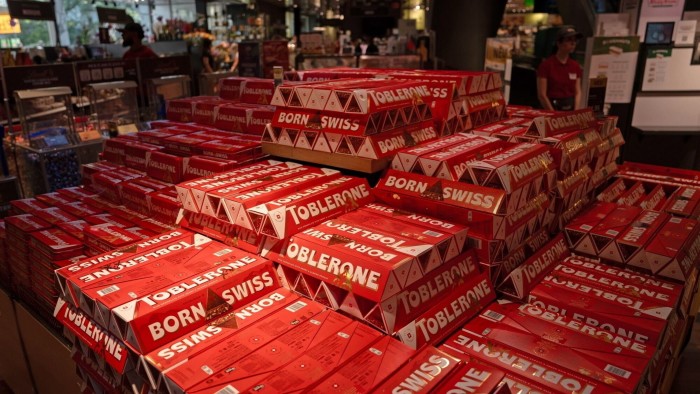The global tariffs Donald Trump wants to drive his economic agenda will take effect at 12.01am in Washington on Thursday, pushing US import duties to their highest level in a century and launching a new era of trade rivalry.
The escalation comes despite frantic lobbying by foreign capitals to escape the levies, after a seven-day grace period the president announced as he unveiled the latest version of the regime last week.
Swiss President Karin Keller-Sutter flew home from Washington on Wednesday after failing in a last-ditch bid to evade some of Trump’s harshest duties. Taiwan, a crucial chips exporter, also failed to cut its tariff rate.
Trump’s new terms follow months of threats and reversals, and involve so-called reciprocal levies on almost all foreign countries, as the president moves to reshape an international trading system developed over decades.
“This is a big deal, in the sense that there are new official tariffs,” said Ted Murphy, a trade lawyer at Sidley Austin in Washington. “It’s a big deal because these tariffs have upended things. This is the dawn of a new trade order, and the end of an old order.”
Other trade analysts pointed out the array of new levies now facing the US’s trading partners.
“We are now in a new world. Even to trade nerds, the complexity of this is just bonkers,” said Chad Bown, senior fellow at the Peterson Institute for International Economics.
The reciprocal tariffs will raise levies even on economies with new US trade deals, including the EU and Japan. China, the world’s biggest exporter, is separate: its trade war truce with Washington ends on August 12.
While Mexico has also agreed a pause in any new tariffs for 90 days, steep new levies on Canada — the US’s other partner in a North American trade group — have already come into effect, to Ottawa’s dismay.
Trump has also said he will soon announce other tariffs on pharmaceuticals, chips and consumer electronics, and other sectors, which are exempt from the reciprocal tariffs.
On Wednesday, he indicated he would hit chip imports with a tariff of 100 per cent, although he did not say when, and also held out the possibility of carve-outs for companies that invested in the US.
The reciprocal regime takes force just hours after the US steepened forthcoming tariffs on India to punish it for buying Russian oil — showing Trump remains ready to use his trade war to pursue geopolitical goals.
The August 7 tariff regime marks the second time the president has instructed US customs to apply the sweeping reciprocal levies. In early April, he pushed ahead with his levies before partially suspending them.
Although Trump’s latest reciprocal tariffs are mostly lower than those he announced on “liberation day” on April 2, they raise the US’s effective tariff to its highest level in decades.
Switzerland’s eleventh-hour bid to escape Trump’s tariffs leaves the Alpine nation — an exporter of pharmaceuticals, precious metals and watches — with a tariff of 39 per cent, one of the highest among developed nations.
Keller-Sutter met US secretary of state Marco Rubio during her trip to Washington this week, but not US trade representative Jamieson Greer or commerce secretary Howard Lutnick, who have both led US trade talks.
Switzerland had initially expected to secure a minimal 10 per cent tariff from the US, in line with the lowest level on offer to other countries. A US official said Trump’s negotiators had not agreed to that.
In a post on X, Keller-Sutter said she had discussed “bilateral co-operation between Switzerland and the US, the tariff situation and international issues” with Rubio.
Trump’s secretary of state has not typically been involved in Washington’s negotiations with trading partners.
US trading partners are now bracing for enforcement of the new regime, while unsure if the president is open to negotiating deals to soften the levies.
Trump has hailed his tariffs for “taking in trillions of dollars” for America, and has boasted that his trade deals are making the US “a rich country again”.
Pantheon Macroeconomics, an independent research group, said on Tuesday that the US had collected about $30bn in customs and excise duties in July, up from about $8bn a month on average in 2024.
Some goods will still be allowed to enter the US without triggering the higher rate of tariff.
According to a Customs and Border Protection notice published earlier this week, goods cleared through US customs from 12.01am on Thursday will be subject to the higher tariffs.
Recommended
However, the notice says goods already en route to the US before 12.01am eastern time on Thursday and that arrive by October 5 will not be subject to the new rates.
Lynn Fischer Fox, a lawyer with Arnold & Porter and former US trade official, said the rules meant that goods arriving by plane, truck or train on or after August 7 would be subject to the higher duties.
The could include air freight leaving Switzerland on August 7 and arriving in the US on the same day, she said.
Lawyers said goods being shipped from further afield, such as Asia, may be able to pay lower rates until October 5, provided they were on the final leg of their journey before August 7.


